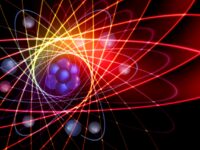What comes to mind when the word “bubbles” is spoken? Well, for many, they would see an image of backyard fun and a lot of empty cans of soap solution. But in the scientific field, bubbles actually play a much bigger role in environmental processes and engineering. Researchers in the areas of sea-air gas exchange, oil pollution, and bioreactions need to have a solid understanding of how bubbles work physically to apply that knowledge to the broader and more turbulent systems they are studying.
Bubbles actually play a much bigger role in environmental processes and engineering.
Information regarding bubbles in turbulent systems has remained the same for the last 70 years, with the well-accepted paradigm, or model, of Kolmogorov-Hinz. The paradigm says bubbles can only be broken by eddies of the same size as the bubble, and sub-bubble scale eddies will have no effect on them. Eddies are constantly swirling currents of water and air that are found within turbulent systems. A study by Rui Ni, an associate professor of mechanical engineering at Johns Hopkins University, and his team actively challenged the Kolmogorov-Hinz paradigm, hypothesizing that eddies of the same size are not the only factor that can break bubbles. Instead, through experiment, Ni and his team discovered that turbulence was somehow breaking bubbles quicker and more intensely than previously thought possible.
What Ni and his team realized was that in full turbulence, it was almost impossible to observe and differentiate what size eddies were directly breaking apart the bubbles. This was the primary reason that no one had been able to disprove the theory laid out in the Kolmogorov-Hinz paradigm. They figured if the bubble-sized eddies could be separated from the sub-bubble-scale eddies, they could expose bubbles to different-sized eddies individually. To experimentally initiate this study, a flow configuration was procured that possessed two identical vortex rings. This created a turbulent flow from the head-on collision between the rings. This was an ideal mechanism because the turbulence could be broken up into two separate parts. In the first part, the vortex rings expanded to create larger bubble-sized eddies. As the rings approached each other, they became unstable, broke down into a turbulent cloud, and created sub-bubbles eddies rather than larger-scale ones.
During the first part of the experiment, bubbles were deformed along the z-axis, in line with the vortexes, until the moment of breakup. This mode was quite slow. Mentioned as the primary breakup and occurring at the moment before the collapse of the two vortex rings, this method of interference was smooth and followed what Kolmogorov-Hinz’s theory said should have occurred. During the second part of the experiment, however, the bubbles referred to as “daughter bubbles” in the study because they came from the breakup of the parent bubble, experienced a much more violent and fast-paced breakup than what should have been expected. This directly disproved the Kolmogorov-Hinz foundation that states the bubbles would have been more difficult to break because of their smaller size and only weaker bubble-scale eddies attacking them. Labeled as the secondary breakup, the effect of the bubble-scale eddies was further studied to exactly gauge how much faster the breakup occurred. It was discovered that secondary breakup occurred in 5.1 milliseconds, compared to the primary breakup which occurred in 32.1 milliseconds.
While bubble-sized eddies were supposed to be the only factor that contributed to bubble breakup, this experiment showed that sub-bubble eddies had just as much to do with the bubble fragmentation process. While the phenomenon is still being studied to further understand why this happens, it is believed that larger energy in the sub-bubble-sized eddies is likely the result of the much faster breaking of bubbles.
What is clear, however, is that this study truly impacts how the scientific community will understand bubble breakup in turbulence and will affect future innovation. In fact, Ni believes that it will also “provide better predictive models for many applications such as pharmaceutical and cosmetic products because the size distribution of their final products are often sensitive to the turbulent fragmentation process.” Perhaps the next step is to use this research’s new application in that backyard bubble fun. Then again, that would probably ruin the simplicity of the whole experience.
Sources:
Nature Communications (2022). DOI: 10.1038/s41467-022-28092-3
Image courtesy of Flickr



